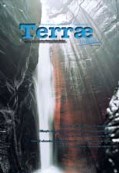Resumo
Este artigo apresenta, em língua portuguesa do Brasil, a Tabela Periódica dos Elementos e seus Íons para Cientistas da Terra, originalmente publicada em inglês. Além de mostrar os elementos em seu estado elementar, o principal diferencial é a incorporação, nesta tabela, das espécies nos múltiplos estados de oxidação que ocorrem naturalmente, o que representa de forma mais fidedigna as condições com as quais os geocientistas normalmente se deparam em seu dia a dia. A nova tabela, consequentemente, mostra muitos elementos por diversas vezes, em diferentes posições, de maneira diferente da tabela convencional. As tendências, padrões, e inter-relações em mineralogia, geoquímica de solos e sedimentos, petrologia ígnea, geoquímica em meio aquoso, geoquímica isotópica e química dos nutrientes, tornam-se perceptíveis neste inovador formato de apresentação. Constitui-se assim em ferramenta importante tanto para iniciantes quanto para os pesquisadores nos níveis mais avançados de investigação em geoquímica, mineralogia e outras ciências afins.
Referências
Bernal J.P., Railsback L.B. 2008. Introducción a la Ta Introducción a la Tabla Periódica de los Elementos y sus Iones para Ciencias de la Tierra. Revista Mexicana de Ciencias Geológicas, 25(2):236-246.
Cartledge G.H. 1928a. Studies on the periodic system. I. The ionic potential as a periodic function. Journal of the American Chemical Society, 50(11): 2855–2863.
Cartledge G.H. 1928b. Studies on the periodic system. II. The ionic potential and related proper
ties. Journal of the American Chemical Society, 50(11): 2863–2872.
Courtney A.1999. A brief history of the development of the periodic table. http://www.wou.edu/las/physci/ch412/perhist.htm.
Dabous A.A., Osmond J.K. 2000. U/Th study of speleothems from the Wadi Sannur Cavern, Eastern Desert of Egypt. Carbonates and Evaporites, 15: 1-6.
De Baar H.J.W., German C.R., Elderfield H., van Gaans P. 1988 Rare earth element distributions in anoxic waters of the Cariaco Trench. Geochimica et Cosmochimica Acta, 52: 1203-1219.
Edwards R.L., Chen J.H., Wasserburg G.J. 1987. 238U-234U-230Th-232Th systematics and the precise measurement of time over the past 500,000 years. Earth and Planetary Science Letters, 81: 175-192.
Farber E. 1969. The Evolution of chemistry. New York: Ronald Press. 437p.
Gaines R.W., Skinner H.C.W., Foord E.E., Mason R., Rosenzweig A. 1997. Dana’s new mineralogy (eight edition). New York: John Wiley and Sons. 1819 p.
Goldschmidt V.M. 1937. The principles of distribution of chemical elements in minerals and rocks. Journal of the Chemical Society, 655–673. The seventh Hugo Müller Lecture delivered before the Chemical Society on March 17th, 1937.
Hem J.D. 1972. Chemical factors that influence the availability of iron and manganese in aqueous solutions. Geological Society of America Bulletin, 83:443-450.
Jin C.Y. 2006. Understanding an earth scientist’s periodic table of the elements and their ions. Journal of Jinhua College of Profession and Technology, 6(1):71-75.
Kaufman A. 1969. The Th-232 concentration of surface ocean water. Geochimica et Cosmochimica Acta, 33:717-724.
Langmuir D. 1978. Uranium solution-mineral equilibria at low temperatures with applications to sedimentary ore deposits. Geochimica et Cosmochimica Acta, 42:547-570.
Mason B. 1958. Principles of Geochemistry. New York: John Wiley and Sons. 310 p.
McDonough W.F., Sun, S.-s. 1995. The composition of the Earth. Chemical Geology, 120:233-253.
McDowell L.R. 1992. Minerals in animal and human nutrition. San Diego: Academic Press. 524 p.
Meunier J.D., Colin F., eds. 2001. Phytoliths: Applications in earth sciences and human history. Exton, Pennsylvania: A.A. Balkema Publishers. 378 p.
Murphy P.J., Stevens G., LaGrange M.S. 2000. The effects of temperature and pressure on gold-chloride speciation in hydrothermal fluids: A Raman spectroscopic study. Geochimica et Cosmochimica Acta, 64:479-494.
Pokrovskii V.A., Helgeson H.C. 1997. Thermodynamic properties of aqueous species and the solubilities of minerals at high pressures and temperatures; the system Al2 O3-H2O-KOH. Chemical Geology, 137:221-242.
Railsback L.B. 2003. An earth scientist’s periodic table of the elements and their ions. Geology,
(9):737-740.
Railsback L.B. 2007. Patterns in the composition of oxysalt and sulfosalt minerals, and the para-
doxical nature of quartz. American Mineralogist, 92:356-369.
Railsback L.B. 2012. An earth scientist’s periodic table of the elements and their ions. Version 4.8e. URL: http://www.gly.uga.edu/railsback/PT/815PeriodicTable48e02.pdf.
Ringwood A.E. 1955. The principles covering trace element distribution during magmatic crystallization: Part I. The influence of electronegativity. Geochimica et Cosmochimica Acta, 7:189-202.
Shock E.L., Sassani D.C., Willis M., Sverjensky D.A. 1997. Inorganic species in geologic fluids; correlations among standard molal thermodynamic properties of aqueous ions and hydroxide complexes. Geochimica et Cosmochimica Acta, 61:907-950.
Stumm W., Morgan J.J. 1996. Aquatic chemistry (third edition). New York: John Wiley and Sons, 1022 p.
Sunde R.A. 1997. Selenium, in O’Dell B.L., eds., and Sunde R.A., eds., Handbook of nutritionally essential mineral elements. New York: Marcel Dekker, Inc., p. 493-556.
Wright J., Schrader H., Holser W.T. 1987. Paleoredox variations in ancient oceans recorded by rare Earth elements in fossil apatite. Geochimica et Cosmochimica Acta, 51:631-644.
A Terrae Didatica utiliza a licença do Creative Commons (CC), preservando assim, a integridade dos artigos em ambiente de acesso aberto, em que:
- A publicação se reserva o direito de efetuar, nos originais, alterações de ordem normativa, ortográfica e gramatical, com vistas a manter o padrão culto da língua, respeitando, porém, o estilo dos autores;
- Os originais não serão devolvidos aos autores;
- Os autores mantêm os direitos totais sobre seus trabalhos publicados na Terrae Didatica, ficando sua reimpressão total ou parcial, depósito ou republicação sujeita à indicação de primeira publicação na revista, por meio da licença CC-BY;
- Deve ser consignada a fonte de publicação original;
- As opiniões emitidas pelos autores dos artigos são de sua exclusiva responsabilidade.

